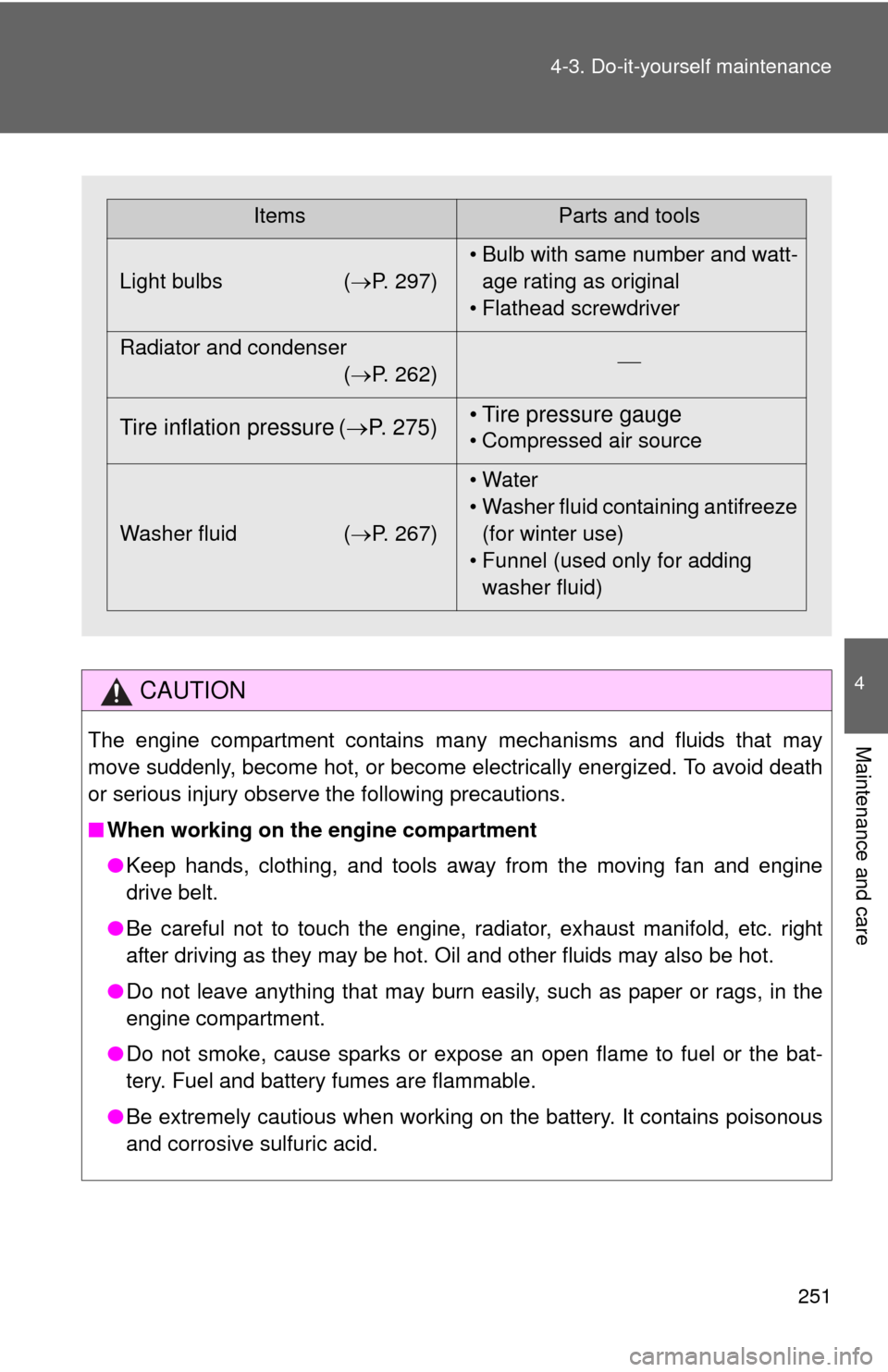Page 4 of 416

TABLE OF CONTENTSIndex
4
4-3. Do-it-yourself maintenanceDo-it-yourself service precautions ...................... 250
Hood................................... 253
Positioning a floor jack ....... 254
Engine compartment .......... 256
Tires ................................... 269
Tire inflation pressure......... 275
Wheels ............................... 279
Air conditioning filter ........... 281
Key battery ......................... 284
Checking and replacing fuses ................................ 286
Light bulbs .......................... 297
5-1. Essential information Emergency flashers ........... 308
If your vehicle needs to be towed ............................... 309
If you think something is wrong ............................... 315
Fuel pump shut off system .............................. 316
Event data recorder............ 317 5-2. Steps to take in an emergency
If a warning light turns on or a warning buzzer
sounds... ........................... 319
If you have a flat tire ........... 329
If the engine will not start .... 341
If the shift lever cannot be shifted from P (vehicles
with an automatic
transmission) .................... 343
If you lose your keys ........... 344
If the vehicle battery is discharged ........................ 345
If your vehicle overheats..... 349
If the vehicle becomes stuck ................................. 352
If your vehicle has to be stopped in an
emergency........................ 354
6-1. Specifications Maintenance data (fuel, oil level, etc.) ........... 358
Fuel information .................. 367
Tire information................... 370
6-2. Customization Customizable features ........ 383
Items to initialize ................. 385
5When trouble arises
6Vehicle specifications
Page 7 of 416
7
Tires
●Rotation
● Replacement
● Inflation pressure
● Information
P. 269
P. 329
P. 275
P. 370
: If equipped
Back door P. 35Side doors P. 31
Fuel filler door P. 74
Rear turn signal lights P. 136
Rear window defoggerP. 193
License plate light P. 150
Stop/tail and rear side
marker lights
P. 150
Rear window wiperP. 155
Page 9 of 416
9
Tires
●Rotation
● Replacement
● Inflation pressure
● Information
P. 269
P. 329
P. 275
P. 370
: If equipped
Back door P. 35Side doors P. 31
Fuel filler door P. 74
Rear turn signal lights P. 136
Rear window defoggerP. 193
License plate light P. 150
Stop/tail and rear side
marker lights
P. 150
Rear window wiperP. 155
Page 164 of 416

164 2-4. Using other driving systems
CAUTION
■Stopping distance when the ABS is ope rating on the wet or slick roads
The ABS is not designed to shorten the vehicle's stopping distance. Always
maintain a safe distance from the vehicle in front of you in the following situ-
ations.
● When driving on dirt, gravel or snow-covered roads
● When driving with tire chains
● When driving over bumps in the road
● When driving over roads with potholes or uneven roads
■ When VSC is activated
The slip indicator flashes and a warning buzzer sounds. Always drive care-
fully. Reckless driving may cause an accident. Exercise particular care when
the indicator flashes and a buzzer sounds.
■ TRAC may not operate effectively when
Directional control and power may not be achievable while driving on slip-
pery road surfaces, even if TRAC is operating.
Do not drive the vehicle in conditions where stability and power may be lost.
■ Replacing tires
Make sure that all tires are of the same size, brand, tread pattern and total
load capacity. In addition, make sure that the tires are inflated to the appro-
priate tire pressure level.
The ABS and VSC will not function correctly if different tires are fitted on the
vehicle.
Contact your Toyota dealer for further information when replacing tires or
wheels.
■ Handling of tires and suspension
Using tires with any kind of problem or modifying the suspension will affect
the driving assist systems, and may cause the system to malfunction.
Page 171 of 416

171
2-5. Driving information
2
When driving
CAUTION
■
Driving with snow tires
Observe the following precautions to reduce the risk of accidents.
Failing to do so may result in a loss of vehicle control and cause death or
serious injury.
●Use tires of the size specified for your vehicle.
● Maintain the recommended level of air pressure.
● Do not drive in excess of 75 mph (120 km/h) regardless of the type of
snow tires being used.
● Snow tires should be installed on all wheels.
■ Driving with snow chains
Observe the following precautions to reduce the risk of accidents.
Failing to do so may result in the vehicle being unable to be driven safely,
and may cause death or serious injury.
●Do not drive in excess of the speed limit specified for the tire chains being
used or 30 mph (50 km/h), whichever is lower.
● Avoid driving on bumpy road surfaces or over potholes.
● Avoid sudden turns and braking.
● Slow down sufficiently before entering a curve to ensure that vehicle con-
trol is maintained.
NOTICE
■Repairing or replacing snow tires
Request repairs of and obtain replacement snow tires from Toyota dealers or
legitimate tire retailers.
This is because the removal and attachment of snow tires affects the opera-
tion of the tire pressure warning valves and transmitters.
■ Fitting tire chains
The tire pressure warning valves and transmitters may not function correctly
when tire chains are fitted.
Page 237 of 416
Maintenance and care4
237
4-1. Maintenance and careCleaning and protecting the vehicle exterior......... 238
Cleaning and protecting the vehicle interior.......... 241
4-2. Maintenance Maintenance requirements .................. 244
General maintenance....... 246
Emission inspection and maintenance (I/M)
programs........................ 249 4-3. Do-it-yourself maintenance
Do-it-yourself service precautions .................... 250
Hood ................................ 253
Positioning a floor jack ..... 254
Engine compartment ........ 256
Tires ................................. 269
Tire inflation pressure ...... 275
Wheels ............................. 279
Air conditioning filter......... 281
Key battery ....................... 284
Checking and replacing fuses .............................. 286
Light bulbs........................ 297
Page 248 of 416
248 4-2. Maintenance
Vehicle exterior
Steering wheel• Moves smoothly?
• Has correct free play?
• No strange noises?
ItemsCheck points
Doors • Operate smoothly?
Engine hood • The lock system works properly?
Fluid leaks • Is there any leakage after park-
ing?
Tire • Inflation pressure is correct?
• Tire surfaces not worn or dam-
aged?
• Tires rotated according to the maintenance schedule?
• Wheel nuts are not loose?
CAUTION
■ If the engine is running
Turn the engine off and ensure that there is adequate ventilation before per-
forming maintenance checks.
ItemsCheck points
Page 251 of 416

251
4-3. Do-it-yourself maintenance
4
Maintenance and care
CAUTION
The engine compartment contains many mechanisms and fluids that may
move suddenly, become hot, or become electrically energized. To avoid death
or serious injury observe the following precautions.
■
When working on the engine compartment
●Keep hands, clothing, and tools away from the moving fan and engine
drive belt.
● Be careful not to touch the engine, radiator, exhaust manifold, etc. right
after driving as they may be hot. Oil and other fluids may also be hot.
● Do not leave anything that may burn easily, such as paper or rags, in the
engine compartment.
● Do not smoke, cause sparks or expose an open flame to fuel or the bat-
tery. Fuel and battery fumes are flammable.
● Be extremely cautious when working on the battery. It contains poisonous
and corrosive sulfuric acid.
ItemsParts and tools
Light bulbs ( P. 297)• Bulb with same number and watt-
age rating as original
• Flathead screwdriver
Radiator and condenser (P. 262)
Tire inflation pressure (
P. 275) • Tire pressure gauge• Compressed air source
Washer fluid ( P. 267)• Water
• Washer fluid containing antifreeze
(for winter use)
• Funnel (used only for adding washer fluid)